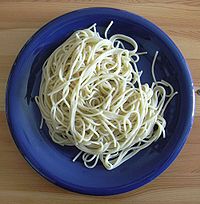Spaghetti
Spaghetti is a long, thin form of pasta. It is versatile, popular, and available throughout the Western world.
Preparation
Most spaghetti sold and consumed is commercially prepared, then dried. Spaghetti is cooked by boiling the pasta in salted water until soft. The consistency or texture of spaghetti changes as it is cooked. One popular consistency is al dente which is translated from the Italian as "to the tooth", that is, soft but with texture. Others prefer their spaghetti fully cooked, which gives it a much softer consistency. To have a perfect "spaghetti al dente", spaghetti should be made from durum wheat semolina, even though spaghetti produced with other kinds of flour can be found outside Italy.
An emblem of Italian cuisine, spaghetti is frequently served in tomato sauce, which may contain various herbs (especially oregano and basil), olive oil, meat, or vegetables. Other toppings include any of several hard cheeses, such as Pecorino Romano, Parmesan or Asiago. Outside Italy it is often served with meatballs, although that is not a typical Italian recipe.
Eating
Eating spaghetti with a fork and a spoon is perfectly polite, being the traditional Neapolitan habit. Many other Italians eat it with just a fork or with the help of the edge of the knife — like most other Continental dishes.
In parts of the US, a narrow size of macaroni is sold as elbow spaghetti. This is a misnomer, as this product is short and tubular, thus it's not a spaghetti at all.
History
While legend has it that Marco Polo brought the recipe for spaghetti back from China, prior evidence showed that pasta has been made in Italy at least since the 4th century BC. In October 2005, a bowl of noodles 4000 years old was unearthed in a Chinese archaeological site as reported by the BBC.[1]
Etymology
The word spaghetti is the plural of the Italian word spaghetto, which is a diminutive of spago, meaning "string," or "twine." The word "spaghetti" literally means "little strings." It is an uncountable noun in English.
See also
External links
- An article about pasta contains detail about date of spaghetti in Italy
- How to cook pasta with step-by-step pictures
- How to eat spaghetti "properly" with a fork
| Pasta | |
|---|---|
| Agnolotti | Bigoli | Bucatini | Cannelloni | Farfalle | Fettuccine | Fusilli | Gnocchi | Lasagne | Linguine | Macaroni | Pappardelle | Penne | Pizzoccheri | Ravioli | Rigatoni | Spaghetti | Tagliatelle | Tortellini | Trenette | Ziti | |
| Total List of Pasta |


